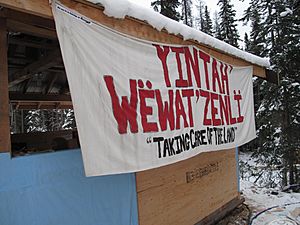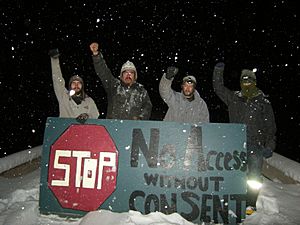Unistʼotʼen Camp facts for kids
The Unistʼotʼen Camp (say it: OO-nis-TAH-den) is a special place built by the Unist'otʼen clan of the Wetʼsuwetʼen Nation. It is located in northern British Columbia, Canada. The camp was set up to protect their traditional land from energy pipelines that companies want to build through it.
The camp is about 1,200 kilometres (750 mi) by road from Vancouver, BC. It is also about 130 kilometres (81 mi) from the town of Smithers, BC. The Wetʼsuwetʼen people have a checkpoint about 20 kilometres (12 mi) east of the camp. At this checkpoint, visitors need permission to enter their territory. They do not allow construction workers or equipment for the pipelines to pass.
In 2019, a company called Coastal GasLink Pipeline went to court. They wanted to build their pipeline, saying they had permission from some Wetʼsuwetʼen councils. But the Unistʼotʼen clan and their supporters did not agree. In 2020, a court order (called an injunction) was made against the Unistʼotʼen clan. In February 2020, the Royal Canadian Mounted Police (RCMP) removed the checkpoints. After this, many protests happened across Canada to support the Wetʼsuwetʼen people.
Contents
Who are the Wetʼsuwetʼen People?
The Wet’suwet’en Nation is made up of five main groups called clans. Each clan has a leader called a hereditary chief. A hereditary chief gets their position from their family, often from a parent who was also a chief. These chiefs are part of a very old system of government that existed before Europeans came to Canada. Their job is to take care of their traditional lands.
The Wet’suwet’en also have an elected council. This council was created after Europeans arrived, under a law called the Indian Act. The elected council works with the Canadian government. Sometimes, there is confusion about whether the hereditary chiefs or the elected council truly speak for all Wet’suwet’en people.
Why Was the Camp Built?
The elected council approved a pipeline to be built on Wet'suwet'en territory. However, the hereditary chiefs did not agree with this plan. Because of this, the chiefs set up the Unistʼotʼen Camp in 2010. The camp is located exactly where the pipelines are planned to cross a creek called Talbits Kwah (also known as Gosnell Creek).
At the camp, there are several buildings and areas. These include a traditional pit house, a garden, greenhouses for growing food, a healing center, and a bunkhouse for people to stay.
In 2015, the Unistʼotʼen clan made a statement. They said that their camp is not just a protest. They are living on and using their traditional land, just as their ancestors have for hundreds of years. They have a rule that means people need their permission to enter their territory. This shows their right to decide who comes onto their land.
Healing and Learning at the Camp
The Unistʼotʼen Camp is also a place for healing and learning. A healing center was built in 2015. This center helps people connect with the land, learn traditional cultural practices, and get better from health problems using Indigenous healing methods.
The Wetʼsuwetʼen people believe that being connected to the land helps with healing. They also believe that the effects of colonialism, like being forced to live away from their traditional lands, can cause harm. The camp also has a youth camp. This gives young people a chance to learn and practice their culture.
The Checkpoint Conflict
The Wetʼsuwetʼen people set up a checkpoint on the Morice River Forest Services Road. This road is several kilometers from the camp. The checkpoint was put there to control who could enter the area and to block the pipeline project.
In 2018, the company TC Energy got a court order (an injunction). This order allowed them to remove the checkpoint so they could build the pipeline. In January 2019, the RCMP came to the territory to make sure the court order was followed. They allowed workers from the Coastal GasLink pipeline project to enter the area. The RCMP arrested 14 people at the checkpoint on January 8. After the pipeline workers finished their early construction work, the blockades were put back up.
Many people who support the blockade believe that the actions taken at the Unistʼotʼen checkpoint were wrong. They also believe that not talking enough with the hereditary chiefs goes against the United Nations' Declaration on the Rights of Indigenous Peoples (UNDRIP). This declaration talks about the rights of Indigenous peoples. Many Indigenous leaders have said that these actions make it harder for the Canadian government to follow the advice from the Truth and Reconciliation Commission Report. This report looked at the history of residential schools in Canada and their impact on Indigenous peoples.
In December 2019, the court order was put in place again. More talks happened, but the pipeline companies could not convince the hereditary chiefs and their supporters to stop their actions. The RCMP returned to the area in 2020. More arrests were made as the RCMP cleared the Morice Forest Service Road. Supporters of the blockade, including those at the camp, stayed along the road. These arrests led to protests in British Columbia and across Canada, all in support of the Wet'suwet'en.
Many groups and schools have shown their support for the Unistʼotʼen Camp. These include OCAD University, the British Columbia Teachers' Federation, and Ryerson University School of Social Work.




